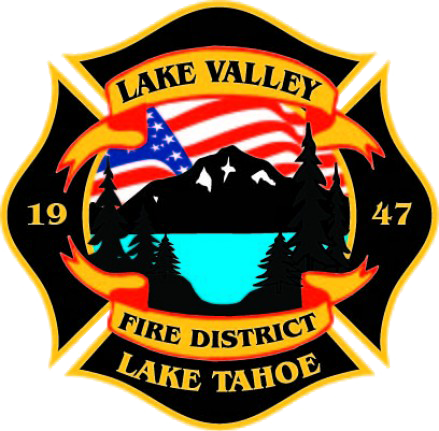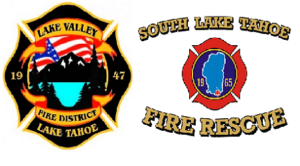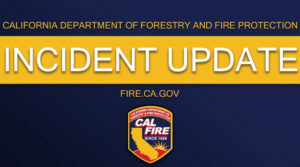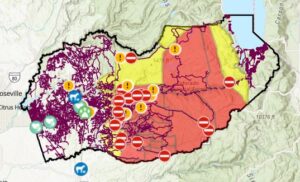by Admin | Nov 25, 2020 | News
PRESS RELEASE
Lower Montgomery Estates Community (Golden Bear) Earns First South Lake Tahoe National Firewise USA® Designation
Meyers, CA Feb 5, 2020 – Residents of the Golden Bear Community have been recognized with a Firewise USA® designation by the National Fire Protection Association, making them the first South Lake Tahoe community to earn this designation.
The Golden Bear Community established neighborhood leaders that partnered with Lake Valley Fire Protection District, CAL FIRE and the Tahoe Resource Conservation District to complete stringent criteria in order to participate in the Firewise USA® program and prepare their community for wildfire. Residents completed a wildfire hazard assessment, developed an action plan to guide their efforts to reduce the risk of wildfire in their community, coordinated a community evacuation drill and created a neighborhood website for dissemination of information as it relates to crises and natural disasters.
When asked why the neighborhood wanted to become a Firewise USA® community, resident Steve Martenson replied “during red flag conditions a house on Lodgepole Trail caught fire. Fire crews were able to extinguish the fire and prevent spread to the neighboring homes and vegetation, but it was a wakeup call. It made us realize that there is more that we can do without relying on local heroes. We wanted to know how we could help ourselves and take steps to make our community safer”.
In order to complete the required criteria homeowners volunteered hundreds of hours of their time to complete defensible space projects, which removed 189 cubic yards of biomass fuels through curbside chipping and defensible space projects with the help of the Tahoe Resource Conservation District’s Fire Adapted Communities Program. The Golden Bear Community invested nearly $13,000 in fire prevention and defensible space work in 2019.
This designation makes Golden Bear one of approximately 1500 neighborhoods in the country recognized for their efforts in wildfire preparedness. Lake Valley Fire Protection District would like to thank community leaders Donarae Reynolds and Patti Assayag along with website designer Steve Martensen for their efforts in helping to establish a Firewise USA® community.
Building on the accomplishments of Golden Bear local agencies have scheduled additional evacuation drills in the Meyers, CA area and will use Golden Bear as their blueprint for success. Communities interested in participating in the Firewise USA® program can learn more at www.firewise.org/usa or contact the Tahoe Resource Conservation District at 530-543-1501 ext. 114.
by Martin Goldberg | Nov 10, 2020 | News

SOUTH LAKE TAHOE, Calif. – A burn ban in the Lake Tahoe Basin was put in place this summer in response to the unprecedented and extreme fire conditions in California. While there were no major fires in the Basin there were record setting acres burned across the state.
A ban of charcoal barbeques, wood fire pits and open burning was but in place along with extra bans during Red Flag Warning conditions.
With the arrival of winter snow, South Lake Tahoe Fire Rescue and Lake Valley Fire Protection District have lifted the ban in the City of South Lake Tahoe and lake portion of El Dorado County. The Forest Service have not released their ban as of Tuesday morning.
● City of South Lake Tahoe – Charcoal BBQs and cooking fires are allowed. Natural Gas (NG) or Propane (LPG) outdoor firepits and barbecues, and pellet grills/smokers are allowed. Solid fuel recreational/warming fires and open burns are NOT allowed.
● Meyers and El Dorado County portions of the Lake Tahoe Basin – Charcoal BBQs and cooking fires are allowed. Natural Gas (NG) or Propane (LPG) outdoor firepits and barbecues, and pellet grills/smokers are allowed. Solid fuel recreational/warming fires are allowed in properly constructed or manufactured firepits. Open burning is still suspended until further notice.
Local South Lake Tahoe fire agency personnel are telling the public they appreciate their adherence to the recent fire restrictions, but ask they remain cognizant and report hazardous fires by dialing 9-1-1.
It is very important to follow manufacturer recommended instructions on the proper care and maintenance of barbecues and/or firepits.
For more information, contact South Lake Tahoe Fire Rescue at (530) 542-6160 or Lake Valley Fire Protection District (530) 577-3737.
by Admin | Jan 25, 2021 | News
The Lake Valley Fire Protection District announces its “Adopt a Fire Hydrant” program.
The Lake Valley Fire Protection District has over 1000 fire hydrants within its borders. It is impossible for fire crews to shovel and maintain all of them in a timely manner. The California Fire Code addresses keeping fire hydrants free of obstructions and immediately identifiable.
The Lake Valley Fire Protection District strives to ensure all hydrants are clear, marked, and accessible in the event of a fire. Winter time makes this job very hard and during heavy snow the district is forced to clear key hydrants first. Some hydrants unfortunately may remain buried all winter.
The Fire District is asking community members to adopt the hydrant closest to their home or business and keep it clear of snow and debris so that together we can help to make our community safer. In the event of a small fire that is reported in a timely manner, the water carried by fire engines is usually sufficient. If a fire is too large for the water carried on an engine, a water source that is easily found can make a difference in keeping the fire from spreading to a neighboring property. Combining safe practices like installing smoke and carbon monoxide detectors, maintaining defensible space, and keeping your closest hydrant clear can prevent unnecessary property damage.
The Lake Valley Fire Protection District appreciates the members of our community that already maintain hydrants in their neighborhood and encourages everyone to participate.
If you notice a fire hydrant that is not marked with a snow stake please contact the Fire Marshal Chad Stephen at (530) 577-3737 or by email at [email protected].
When maintaining a hydrant, a three foot clear space should be maintained around the hydrant and to the roads edge. Below is an example of hydrants being cleared by helpful citizens of our community.
Lake Valley Fire Protection District, Fire Chief Brad Zlendick said that “the Fire District’s adopt a fire hydrant program is an important step in assuring that firefighters have access to an adequate water supply in the event of a fire”.
The Lake Valley Fire Protection District has its website at www.lakevalleyfire.org. Check out the website for information on the many services the Fire District is proud to offer to the community.
by Martin Goldberg | Aug 22, 2021 | News
Caldor Fire Information
 The Lake Valley Fire Protection District appreciates your efforts to stay informed on this rapidly changing wildfire. The District is working closely with the Caldor Fire Incident Management Team including CALFIRE and the U.S. Forest Service and will continue to do so throughout the incident. All our actions are based on the most current fire information. The District wants our community to be informed and provide the following incident information. The incidents information line is (530) 303-2455 and the media line is (530) 497-0315.
The Lake Valley Fire Protection District appreciates your efforts to stay informed on this rapidly changing wildfire. The District is working closely with the Caldor Fire Incident Management Team including CALFIRE and the U.S. Forest Service and will continue to do so throughout the incident. All our actions are based on the most current fire information. The District wants our community to be informed and provide the following incident information. The incidents information line is (530) 303-2455 and the media line is (530) 497-0315.
Fire Information
The Caldor Fire Public Information Team provides information twice daily, at 7 am and at 7 pm. Other notices regarding evacuations, smoke impacts and community meetings are released throughout the day. These can be obtained directly by email or by social media. For emails, click here. To Like the CALFIRE Amador-El Dorado Unit Facebook page and get incident updates, click here. To Like the U.S. Forest Service – Eldorado National Forest Facebook page and get incident updates, click here.
Statewide fire Information can be found on CALFIRE’s main website at www.fire.ca.gov. For Caldor Fire information on CALFIRE’s website click here https://www.fire.ca.gov/incidents/2021/8/14/caldor-fire/. Another great resource for fire information, go to InciWeb at https://inciweb.nwcg.gov/. Calfor fire information can be found on the InciWeb site at https://inciweb.nwcg.gov/incident/7801/.
Evacua tion Information
tion Information
Please note, there is no evacuation order, nor warning, issued in the Lake Tahoe Basin area as of Sunday, August 22. However, this is a good time to assemble an emergency supply kit should the need arise to evacuate. You can find information at Emergency Supply Kit – Ready for Wildfire. Additionally, information on how to prepare family members in the event of an evacuation can be found at Prepare Your Family – Ready for Wildfire. Click the map for current El Dorado County Evacuation information.
by Martin Goldberg | Aug 26, 2021 | News
Tahoe Fire and Fuels Team
August 26th, 2021
Contact: Amanda Milici, Tahoe Resource Conservation District, (530) 543-1501 x 114
LAKE TAHOE, Calif./Nev. – Since the 2007 Angora Fire, the Tahoe Fire and Fuels Team (TFFT) has completed 65,000 acres of treatment to reduce hazardous fuels in the Tahoe Basin. These restoration projects improve the vitality of the basin’s forests to withstand the increasing threats of drought and other extreme weather events. With the Caldor Fire nearby, we want to share what you can do individually to complement the work that the TFFT is doing to prepare for wildfire.
Monitor Incident Information – Stay up to date on the current acreage and containment statistics by visiting the incident page here and sign up to receive CAL FIRE updates here. For current evacuation locations, check the El Dorado County Sherriff Evacuation Map. For the latest Caldor Incident information, attend a live CAL FIRE AEU community meeting daily at 5PM at www.facebook.com/CALFIREAEU.
Highway 50 is closed in both directions from Pollock Pines (Sly Park Road exit) to Meyers. Check the CAL FIRE incident page and the Caltrans QuickMap for road closure updates.
Sign Up for Emergency Alerts –You should take initiative by signing up for emergency alerts. Placer Alert, El Dorado County Code Red, Douglas County Code Red, and Washoe County Code Red allow individuals to register up to five addresses for notifications. Those who often travel around Lake Tahoe should sign up for all four counties.
Prepare an Evacuation Go-Bag – Prepare a Go-Bag in advance, and include 3-5 days of supplies you would need to self-sustain should you be ordered to evacuate. Include essentials such as clothes, toiletries, prescriptions, food, water, cash and pet supplies. Make sure your personal documents (such as social security card, passport, and memorabilia) are accessible. Consider adding a USB drive with copies of these documents to your Go-Bag.
Plan for a Potential Evacuation – Evacuating can be stressful and scary, so you should have a plan. Familiarize yourself with your neighborhood, identify potential escape routes, and build relationships with your neighbors, especially if you do not have a car. Learn how to turn off the gas and electricity at your home, designate a family meeting point, and identify an out-of-town contact. Prepare to address the special needs of vulnerable family members and neighbors, including the elderly and those with medical problems or disabilities. In the event that you have to evacuate, use this Wildfire Evacuation Checklist for guidance. Practice the plan with your family, pets and neighbors. Muscle memory will help in times of real emergency.
Do a Home inventory – If, and only if, you have time, consider documenting your important items in the event you need to file an insurance claim. Document your home inventory here or use the home inventory app here. Take photos and/or videos of your most important items.
Visit TahoeLivingWithFire.com and follow @tahoelwf on Facebook, Instagram, and Twitter for more wildfire preparedness and prevention information.
About the Tahoe Fire and Fuels Team – The Tahoe Fire and Fuels Team (TFFT) consists of representatives of Tahoe Basin fire agencies, CAL FIRE, Nevada Division of Forestry and related state agencies, University of California and Nevada Cooperative Extensions, the Tahoe Regional Planning Agency, the USDA Forest Service, conservation districts from both states, the California Tahoe Conservancy and the Lahontan Regional Water Quality Control Board. Our Mission is to protect lives, property and the environment within the Lake Tahoe Basin from wildfire by implementing prioritized fuels reduction projects and engaging the public in becoming a Fire Adapted Community.



